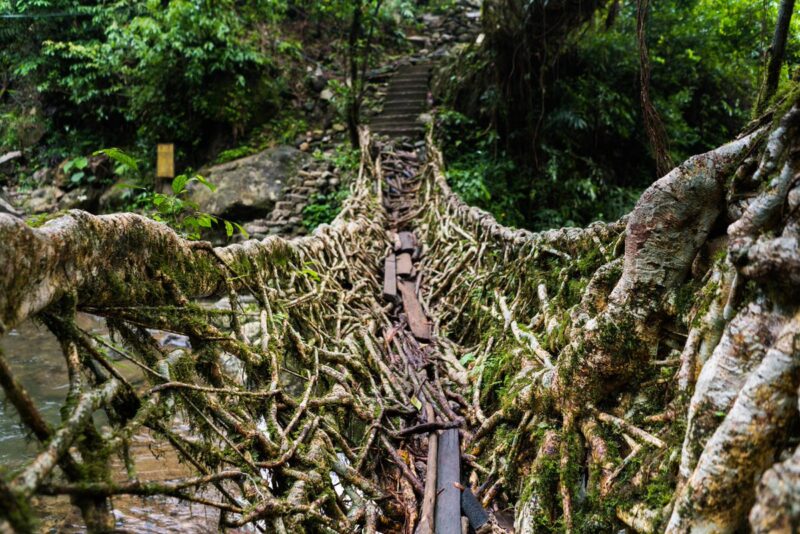In the lush and enchanting landscapes of Meghalaya, a state in northeastern India, an extraordinary form of architecture exists that showcases the harmonious relationship between humans and nature. These incredible structures, known as living root bridges, are living testimonies to nature’s ingenious engineering. In this article, we will explore the fascinating world of living root bridges, their history, construction, and significance, while marveling at the remarkable harmony between humans and the natural world.
Table of Contents
- Introduction
- The Living Root Bridges of Meghalaya
- The History and Tradition
- The Remarkable Construction Process
- Nature’s Incredible Adaptability
- The Strength and Durability
- The Ecological Significance
- Cultural and Touristic Importance
- The Future of Living Root Bridges
- Sustainable Solutions
- Conclusion
- FAQs
The Living Root Bridges of Meghalaya
Tucked away amidst the misty valleys and verdant hills of Meghalaya, a unique form of architecture exists that captivates visitors from around the world. The living root bridges, as the name suggests, are bridges made entirely from living tree roots. They are a stunning example of the harmony that can be achieved between humans and nature.
The History and Tradition
The tradition of building living root bridges has been passed down through generations in the Khasi and Jaintia tribes of Meghalaya. It is believed that the practice originated centuries ago when the local communities discovered the incredible natural potential of the Ficus elastica tree, locally known as the “Indian rubber tree.” The knowledge of guiding and training these tree roots to create living bridges has been preserved and nurtured by the indigenous people.
The Remarkable Construction Process
Creating a living root bridge is a labor-intensive and time-consuming process that requires careful planning and patience. The bridge construction begins by guiding the pliable aerial roots of the Ficus elastica tree across a stream or river. The roots are carefully intertwined and allowed to grow and strengthen over several years. As the roots grow, they are guided and manipulated using bamboo scaffolding and other supportive materials. Over time, a sturdy and flexible living bridge takes shape, capable of withstanding the forces of nature.
Nature’s Incredible Adaptability
One of the most remarkable aspects of living root bridges is nature’s adaptability and responsiveness. As the roots grow and intertwine, they naturally reinforce themselves, becoming stronger with time. This unique property allows the bridges to withstand the monsoons, floods, and the weight of countless people who traverse them daily. It is a testament to the resilience and adaptability of nature’s design.
The Strength and Durability
Living root bridges are not only aesthetically pleasing but also incredibly strong and durable. These organic structures can withstand the test of time, with some bridges estimated to be over five centuries old. Unlike conventional bridges that require frequent maintenance and repairs, living root bridges grow stronger with age. This self-sustaining nature is a testament to the sustainable engineering principles employed by nature itself.
The Ecological Significance
Beyond their functional and visual appeal, living root bridges also possess immense ecological significance. The process of constructing these bridges involves minimal harm to the environment, as it utilizes the natural resources already present in the region. Additionally, the roots of the Ficus elastica tree have a positive impact on the surrounding ecosystem, promoting soil conservation, preventing erosion, and providing habitat for various organisms.
Cultural and Touristic Importance
The root bridges have become iconic symbols of Meghalaya’s cultural heritage and have garnered international recognition. Visitors from all corners of the globe flock to witness these marvels of nature, immersing themselves in the rich traditions and natural beauty of the region. The bridges serve as a bridge between the past and the present, connecting generations and fostering a deep sense of pride among the local communities.
The Future of Living Root Bridges
As we navigate an era of rapid urbanization and environmental challenges, preserving the legacy of root bridges becomes crucial. Efforts are being made to document, protect, and promote these unique structures. With increased awareness and support, sustainable tourism practices can be implemented, ensuring that these architectural wonders continue to thrive for future generations to admire.
Sustainable Solutions
To ensure the sustainability of root bridges, it is essential to strike a balance between preservation and responsible tourism. Engaging the local communities in conservation efforts, implementing eco-friendly practices, and educating visitors about the cultural and ecological significance of these bridges are vital steps toward their long-term preservation.
Conclusion
Living root bridges stand as remarkable examples of human ingenuity and nature’s resilience. These extraordinary structures not only serve as functional crossings but also embody the harmonious coexistence between humans and the environment. As we marvel at their timeless beauty and engineering brilliance, let us also embrace the lessons they teach us about sustainable living and the remarkable power of nature.
Similar Articles
FAQs
Are living root bridges safe to cross?
Root bridges are known for their strength and durability, making them safe to cross. The Indigenous communities regularly maintain and monitor these bridges to ensure their safety.
How long does it take to construct a living root bridge?
The construction process of a living root bridge can take anywhere from 10 to 15 years, depending on the complexity and size of the bridge.
Can living root bridges withstand natural disasters?
Root bridges have shown remarkable resilience against natural disasters like monsoons and floods. Their flexibility and organic structure enable them to withstand such forces.
Do living root bridges require maintenance?
Root bridges are self-sustaining and require minimal maintenance. However, regular monitoring and occasional repairs are undertaken by the local communities to ensure their longevity.
How can visitors contribute to the preservation of living root bridges?
Visitors can contribute to the preservation of Root bridges by practicing responsible tourism, respecting the local culture and environment, and supporting initiatives that promote their conservation.









